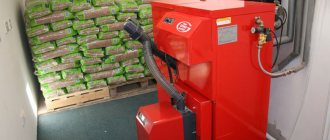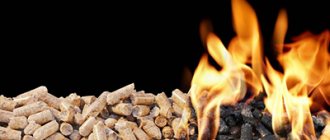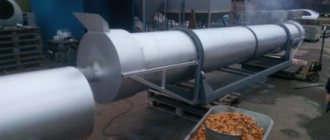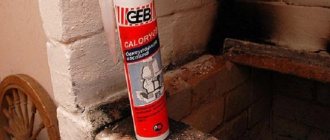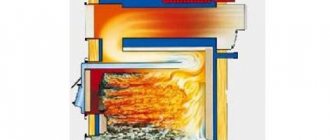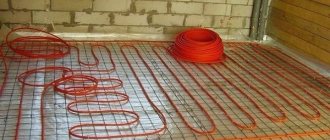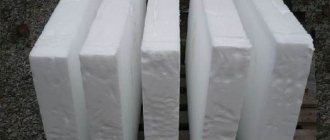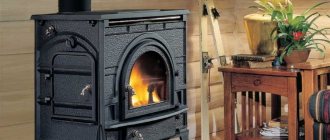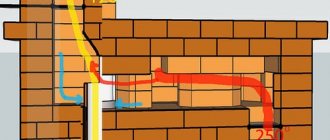Manually firing the stove with pellets
One of the simplest and cheapest formats for using such pellets involves manually adding fuel to the stove. For many people, this process seems unnecessarily complicated and incomprehensible, since the first time it is not possible to calculate the exact amount of fuel and the time of its addition.
After just a few times, you will be able to understand the features of the process and will easily control the flame power and the “operating” combustion temperature.
You can heat a stove with pellets in a conventional stove without significant modifications:
- The easiest way is to install a specialized basket in the oven. It has a fine-mesh structure, which prevents burnt pellets from falling into the ash pit. The cost of such products is extremely affordable, so every stove owner can afford it.
- If you want to do the work yourself without purchasing additional products, you should manually reduce the gaps between the grates. To do this, you need to re-weld the grate with a decrease in clearance or install a special mesh, which is made of thickened wire.
How to heat a stove with pellets: methods and rules of use
Many owners of private houses want to heat their stoves with pellets, which are a composite fuel with high thermal capacity. They have many advantages over conventional firewood, which explains their high popularity.
Despite the fairly simple structure of fuel pellets, many citizens have a question about how to properly heat a simple brick stove with pellets and whether this process can be carried out at all.
Is it possible to burn a regular stove with pellets?
It was previously mentioned that pellets are extremely active in everyday life, but a special stove and burner system is required to ensure a normal flame and a uniform heat transfer process.
Despite a number of limitations, pellets can be burned without much difficulty in a conventional stove, however, the advantages of fuel in this format of use are often lost.
The main positive features of the material are:
- Long burning life;
- Low emission of smoke and toxic substances;
- High amount of thermal energy;
- Burnout uniformity.
If you plan to burn pellets in a standard stove without significantly upgrading it, then they will simply burn like regular firewood. Due to their high cost, this format of use becomes unprofitable.
Most often, minor modifications are required according to proven schemes. All of them differ from each other in their complexity, cost of implementation and the need for additional equipment. Despite all the difficulties, already in the first hours after the upgrade you will be able to forget about the difficulties that haunted you earlier.
Manually firing the stove with pellets
One of the simplest and cheapest formats for using such pellets involves manually adding fuel to the stove. For many people, this process seems unnecessarily complicated and incomprehensible, since the first time it is not possible to calculate the exact amount of fuel and the time of its addition.
After just a few times, you will be able to understand the features of the process and will easily control the flame power and the “operating” combustion temperature.
You can heat a stove with pellets in a conventional stove without significant modifications:
- The easiest way is to install a specialized basket in the oven. It has a fine-mesh structure, which prevents burnt pellets from falling into the ash pit. The cost of such products is extremely affordable, so every stove owner can afford it.
- If you want to do the work yourself without purchasing additional products, you should manually reduce the gaps between the grates. To do this, you need to re-weld the grate with a decrease in clearance or install a special mesh, which is made of thickened wire.
Despite the wide range of options, using a special basket is the most optimal choice, which has been tested by thousands of people. Be sure that you will certainly appreciate the ease of use!
Using a pellet burner for a stove
Pellet burners are a universal device that fully automates the fuel supply process and maintains a given temperature.
Today on the market you can find a large number of models that have proven themselves successfully. They can operate both using electrical energy and compressed gas. The first option is safer, since the energy supply can be instantly limited in case of an emergency.
Example of a pellet burner
An important feature of such burners is the automated fuel supply mechanism, which does not require outside intervention. All you need to do is enter the settings, check their correctness, change them to the required values if necessary, and then just monitor the availability of fuel
Modern pellet burners have several main parts, including:
- Transport fuel supply mechanism;
- Ignition and fire control systems;
- Microprocessor for automated control of the combustion process;
- The actual body.
The cost of such products is quite high, but the comfort they provide is worth the money spent!
Design and principle of operation
In a brick oven
Installing a burner in a brick oven is quite simple:
- The burner body itself is inserted into the oven, and then carefully secured with screws and other materials.
- Usually there is no gap between the furnace mouth and the burner wall, however, if there is a large diameter hole, it is recommended to seal it with specialized sealants.
- If the burner is electrically powered, the power cable must be protected from high temperatures. It is usually vented away from the furnace and direct flame exposure, so no additional design modification is required.
- The last step is to secure the pellet storage chamber on top of the burner. The case has a special mechanism, so you only need to install it in the appropriate grooves.
Examples of installation in the photo:
In a metal oven
Installing a pellet burner on a metal stove is practically no different from the brick version
The only thing you should pay attention to is to prevent contact of the burner body with the walls of the furnace, since high temperatures can lead to failure of the mechanism
Pellet burner installed in a potbelly stove with a hopper
Pellet loading technique
Heating a simple brick stove with pellets is quite simple. If the burner has an electric ignition mechanism, then you just need to press a special button. Cheaper models do not have this functionality, so a gas burner is used.
The combustion rules are quite simple - fuel should be supplied evenly and fairly slowly. If a large amount of ash is formed, then the feed rate should be reduced, since the pellets simply do not have time to burn, but melt under the influence of high temperature.
When any type of fuel is burned, heat is released. The same will happen when pellets burn inside a fireplace or stove. Pellets are a popular type of fuel, which is gaining more and more positive responses from consumers. The combustion of pellets consists of four different stages, during which the temperature of the fuel inside the firebox will differ.
Let's look at each stage in detail and dwell in more detail on the combustion temperature of pellets:
— The first stage is evaporation of moisture and drying of the fuel. Once the pellets are inside the combustion chamber, moisture begins to release from them. At this moment, the pellets immediately fall into a hot space, so they dry instantly, and the accumulated moisture, which is not so much, comes out of them. Another reason for the rapid drying and combustion of pellets is, of course, their small size and porosity. Pellets contain 7-12% moisture, firewood contains 30%. Moisture leaves this fuel faster.
— The second stage is pyrolysis or gasification. After the fuel dries, gas generator gas is formed, at such moments methane, CO, H, CH4, as well as impurities are released. In order for the combustion process to be maintained, it is necessary to achieve a pellet combustion temperature of 270 degrees Celsius. The emitted gas can be used externally: for example, in internal combustion engines.
— The third stage is combustion of the released gas. Once the pellets have reached combustion temperature and if there is sufficient oxygen supply, the gasifier gas released will burn. Here a classic scheme occurs: hydrogen and oxygen combine, water is formed. The hydrocarbon combines with carbon dioxide, which ultimately leads to the release of water vapor. If the components are in short supply, then, accordingly, the efficiency of the unit becomes less, the heat simply evaporates into the chimney.
— The fourth stage is coal combustion. As soon as all the gases have been released and burned, the process of burning charcoal begins. When pellets are burned, 80% of the energy is lost as gases, and 20% is released as coal.
Pellet combustion temperature
In order for the combustion process of pellet granules to always proceed correctly, firstly, it is always necessary to choose high-quality fuel from trusted companies, and also, secondly, to ensure access to oxygen in optimal quantities, as when using any other type of fuel. The uniform flow of pellets into the firebox is also important: so that one part undergoes the gasification stage in a timely manner, then burns completely, and then the next portion of pellets enters the combustion chamber.
The calorific value of pellets, depending on the quality and other characteristics, is 19 MJ/kg (4500 Kcal/kg). The average efficiency of pellets is 93%. 1 kg can be equated to 5 kW of electricity:
1 kW = 200 grams of pellets/hour;
30 kW = 6 kg pellets/hour;
50 kW = 10 kg pellets/hour.
The following comparative analysis of pellets can be given to other heating methods:
1 kg pellets = 5 kW of electricity;
2 kg pellets = 1 cubic meter of gas.
During the combustion process of pellet granules, carbon dioxide emissions are 10-50 times lower, ash content is 15-20 times lower, and there is no sulfur emission.
Tags pellet chopper, pellets, garage heating, pump, heating elements
Comments 28
Hello...what do you recommend about such a burner?!
since they sell it and it seems like a well-known company should work, our boiler is still supercharged and forced automatic feed, here everything works due to the draft and weight of the pellets
... well, yes, there is also no gas in the house, and even for propane cylinders - in the winter they fill strictly in a certain amount (a ruined country!), so I’m thinking of buying pellets - but the prices are exorbitant - and then I recently came across it on the market! - and a hydraulic accumulator for what at all?
supposedly the boiler always circulates water over 60 degrees in a small circle, constantly through just the hydraulic accumulator - a small circle, and then it takes into the system as much as it needs and at what temperature it needs
It’s strange about propane - take as much as you like from us
... in severe frost - yes, they limit it (two gas stations, not enough for everyone), queues form, fights even break out, people go to neighboring villages ... the village of Staromyshastovskaya is our name, 25 km from Krasnodar
trouble. It’s easier with us of course
how much water (coolant) is in the system?
estimated 2000 l
Very cool description!
I don’t fully understand your tariffs and prices, respectively. In general, is it more profitable than state centralized gas supply or not?
It turned out cheaper for us than heating from central heating; we couldn’t run our own gas, otherwise we would of course be on gas
that is, despite the fact that gas is more expensive, would you choose gas if there was an opportunity?
I have a private house that is heated with 2 gas boilers, the cost of gas is much less than that of pellets. I’m telling you this now, as a person who has experienced this. For comparison, a house of 200 m2, for gas with cooking they pay about 6,000 rubles a month , even if we interpolate by area, taking into account the worst thermal insulation, I think we will never reach 30,000
plus don’t forget the tariffs for individuals and legal entities, they vary quite a bit
ah... no, I was always sure that gas is more expensive in any case... Although your gas tariffs are probably cheaper, unlike ours
If you believe all the forums, the only thing cheaper than gas is firewood, moreover, cut down personally, dragged on your back, chopped, and personally thrown into the boiler. Moreover, all this must be done between work, family and rest.
I will answer everyone at once. I am heating two rooms in different buildings: - the first is 240 m2, 3.5 m ceilings, a separate building, the gates are illuminated, there are 6 windows, very poor thermal insulation, in winter there was snow from the central heating when heating, it did not lie in any frost - the second 85 m2, ceilings 5 m, located inside an unheated workshop, solid (gate only)
The second workshop is 7 degrees warmer than the first. The first workshop was not insulated before winter. The holes were only patched
When we heated from central heating it didn’t matter, in the workshop it was always + 12-14 in any frost
Last year, the cost of heat in the first workshop was 22 per month. This year a second workshop appeared. We calculated 25 for one and proportionally 10 for the second. You guessed wrong! The new owner of the boiler room gave an estimate - 60 and 25 per month, respectively, plus a recalculation is possible due to frost.
It’s difficult with gas, although it’s not far away, but the circle is only broached and the project under the strap.
Since I wanted autonomy, I scrapped the pyrolysis boiler. The only thing left is the pellet one. I buy the pellets themselves at 6-6.3 per kg, it’s winter and the season, so I’ll stock up in the summer. A 90 kg bunker is enough to keep at -25 frost for 6-7 hours during the day in the first workshop from 3 to 7 in different places. With the same frost, the second workshop is 5-7 degrees warmer. I set the night mode to twice as economical, the same volume is enough for 10-12 hours. I haven’t measured it more precisely, usually a ton per week steadily flies away.
Here’s the breakdown, heating costs 25-30 kilorubles, plus delivery of pellets and problems with filling and cleaning. The system cost about 300, taking into account the creation of a new heating system in the second workshop.
Is it possible to burn a regular stove with pellets?
It was previously mentioned that pellets are extremely active in everyday life, but a special stove and burner system is required to ensure a normal flame and a uniform heat transfer process.
Despite a number of limitations, pellets can be burned without much difficulty in a conventional stove, however, the advantages of fuel in this format of use are often lost.
The main positive features of the material are:
- Long burning life;
- Low emission of smoke and toxic substances;
- High amount of thermal energy;
- Burnout uniformity.
Most often, minor modifications are required according to proven schemes. All of them differ from each other in their complexity, cost of implementation and the need for additional equipment. Despite all the difficulties, already in the first hours after the upgrade you will be able to forget about the difficulties that haunted you earlier.
How to heat a regular stove with pellets
To answer the question whether a conventional stove can be heated with pellets, it is necessary to take into account the combustion features of granular fuel and the design of the combustion chamber. Fuel wood pellets have high heat transfer and burn much longer than firewood.
How to heat a simple stove with pellets
Using pellets in a conventional stove is possible and profitable. Any stove can be heated with pellets, regardless of its design and operating principle. To make it possible to use compressed fuel, you will need to modify the furnace device or install a burner device.
Each option has its own characteristics, advantages and disadvantages. When choosing the operating principle of the furnace, pay attention to the following characteristics:
- Autonomy.
- The need for material additions.
- Dependence on electricity.
- Heat dissipation.
Advantages and disadvantages of fuel briquettes
Let's see what good fuel briquettes are for heating stoves, and what are their main pros and cons. Let's start with the positive features:
You are unlikely to have any problems with storing and storing European firewood.
- Ease of storage – thanks to its neat shape, Euro firewood and other briquettes can be stacked in neat, even stacks;
- High calorific value of fuel briquettes - if we compare them with ordinary firewood, they provide one and a half to two times more heat. Due to this, you can save on fuel when firing stoves and boilers;
- Briquettes are a long-burning fuel for any type of stove. Pressed sawdust burns one and a half to two times longer, reducing the number of approaches for adding new portions of fuel. If there is a regular stove in the room that burns with wood for 2-3 hours, then with fuel briquettes this time will increase to 4-5 hours;
- Uniform burning, without unnecessary noise and embers shooting in all directions. In addition, fuel briquettes used to fire stoves emit less smoke and produce less ash, reducing labor costs for cleaning;
- Low formation of resins - this reduces chimney clogging;
- The storage duration of fuel briquettes for heating stoves varies from 1 year to 5 years - it all depends on the manufacturing technology;
- High environmental friendliness - no chemicals are used in the production of briquettes;
- The volume of briquetted fuel consumed during one heating season is 1.5-2 times less than the volume of firewood used during the same time period.
Fuel briquettes intended for heating stoves burn smoothly and softly, releasing a large amount of heat. They do not clog stoves and chimneys and burn almost 99%.
Unfortunately, it was not without certain disadvantages:
We do not recommend storing briquettes outdoors; they can become damp and spoil.
- Fuel briquettes used to fire stoves are not afraid of dampness. However, they still do not like direct contact with water;
- Some types of briquetted fuel do not tolerate long-term storage - their shelf life is limited to one year from the date of manufacture;
- The cost of purchasing fuel may be higher than purchasing regular firewood - it all depends on the manufacturer;
- In some regions and localities, purchasing fuel briquettes for heating boilers and stoves is more difficult than buying a truckload of ordinary firewood;
- The cost is slightly higher than the cost of ordinary firewood. But due to the high calorific value and long combustion, you can save a little.
Despite all this, briquetted fuel continues to gain popularity.
How to use granules
Since gas boilers are used for gas heating, and electric boilers are used for electric heating, it is advisable to use a specially prepared unit - a pellet boiler - to heat residential premises using pellets. The reason for this lies in the optimization of equipment for special fuels, which increases the efficiency of its use. Although a traditional wood-burning stove can be used to meet minimum needs.
Such heating devices operating on pellets have a design no less pleasant than models running on gas, diesel or electricity. However, they require the presence of a container for storing new portions of fuel. Usually the full volume is enough to keep the equipment in continuous operation for 24 hours.
Over time, new technologies are being introduced into equipment models. For example, there are devices that require fuel loading once a week or season. Such equipment is equipped with large fuel tanks.
The key feature affecting fuel consumption is the outside temperature, but the temperature that needs to be maintained indoors is no less important.
Pellet boilers operate according to the following algorithm:
- the auger directs the granules into the oven;
- pellets are ignited using electricity;
- automatic combustion support;
- The layered plate is heated, which subsequently transfers its heat to the room.
